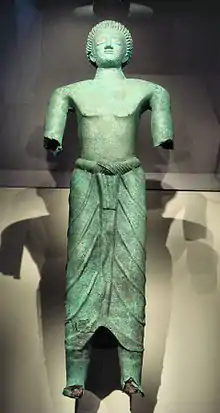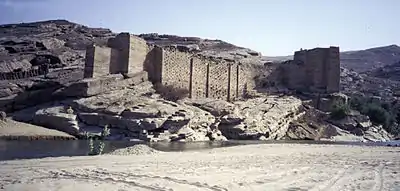Sabaeans
The Sabaeans or Sabeans (Sabaean: 𐩪𐩨𐩱, S¹Bʾ; Arabic: ٱلسَّبَئِيُّوْن, as-Sabaʾiyyūn; Hebrew: סבאים) were an ancient people of South Arabia. They spoke the Sabaean language, one of the Old South Arabian languages.[2] They founded the kingdom of Sabaʾ (Arabic: سَـبَـأ),[3][4] which was believed to be the biblical land of Sheba[5][6][7] and "the oldest and most important of the South Arabian kingdoms".[8]
Sabaean Kingdom مَمْلَكَة سَبَأ (in Arabic) | |||||||
|---|---|---|---|---|---|---|---|
| between 1200 and 800 BCE–CE 275 | |||||||
| Capital | Sirwah Maʼrib, Sana'a | ||||||
| Common languages | Sabaic | ||||||
| Religion | pre-Islamic Arabian religions | ||||||
| Government | Theocracy (Early) Monarchy (Late)[1] | ||||||
| Mukarrib | |||||||
• 700–680 BCE | Karibi-ilu | ||||||
• 620–600 BCE | Karib'il Watar | ||||||
• 60–20 BCE | Ilasaros | ||||||
| Historical era | Iron Age to Classical Antiquity | ||||||
• Established | between 1200 and 800 BCE | ||||||
• Disestablished | CE 275 | ||||||
| |||||||
The date of the foundation of Sabaʾ is a point of disagreement among scholars. Kenneth Kitchen dates the kingdom to between 1200 BCE and 275 CE, with its capital at Maʼrib.[9] On the other hand, Israel Finkelstein and Neil Asher Silberman write that "the Sabaean kingdom began to flourish only from the eighth century BC onward" and that the story of Solomon and the Queen of Sheba is "an anachronistic seventh-century set piece."[10] The Kingdom fell after a long but sporadic civil war between several Yemenite dynasties claiming kingship;[11][12] from this the late Himyarite Kingdom arose as victors.
Sabaeans are mentioned several times in the Hebrew Bible. In the Quran,[13] they are described as either Saba’,[3][4] or as the people of Tubba' (Arabic: قَـوْم تُـبَّـع, romanized: Qawm Tubbaʿ).[14][15]
History

The origin of the Sabaean Kingdom is uncertain. Kenneth Kitchen dates the kingdom to around 1200 BCE,[16] while Israel Finkelstein and Neil Asher Silberman write that "the Sabaean kingdom began to flourish only from the eighth century BCE onward".[17] Originally, the Sabaeans were one of the shaʻbs (Sabaean: 𐩦𐩲𐩨𐩪), "communities", on the edge of the Sayhad desert. Very early, at the beginning of the 1st millennium BC, the political leaders (Sabaean: 𐩱𐩣𐩡𐩫, romanized: ʼmlk) of this tribal community managed to create a huge commonwealth of shaʻbs occupying most of South Arabian territory and took the title Sabaean: 𐩣𐩫𐩧𐩨 𐩪𐩨𐩱, romanized: mkrb sbʼ, “Mukarrib of the Sabaeans”.[18]
Several factors caused a significant decline of the Sabaean state and civilization by the end of the 1st millennium BC.[19] Saba' was conquered by the Himyarite Kingdom in the first century BCE; but after the disintegration of the first Himyarite Kingdom of the Kings of Saba' and Dhū Raydān, the Middle Sabaean Kingdom reappeared in the early second century.[20] Note that the Middle Sabaean Kingdom was different from the Ancient Sabaean Kingdom in many important respects.[21] The Sabaean kingdom was finally conquered by the Ḥimyarites in the late 3rd century and at that time the capital was Ma'rib. It was located along the strip of desert called Sayhad by medieval Arab geographers, which is now named Ramlat al-Sab'atayn.
The Sabaean people were the South Arabian people. Each of these peoples had regional kingdoms in ancient Yemen, with the Minaeans in the north in Wādī al-Jawf, the Sabeans on the southwestern tip, stretching from the highlands to the sea; the Qatabānians to the east of them, and the Ḥaḑramites east of them. The Sabaeans, like the other Yemenite kingdoms of the same period, were involved in the extremely lucrative spice trade, especially frankincense and myrrh.[22] They left behind many inscriptions in the monumental ancient South Arabian script or Musnad, as well as numerous documents in the related cursive Zabūr script.
Religious practices

Muslim writer Muhammad Shukri al-Alusi compares their religious practices to Islam in his Bulugh al-'Arab fi Ahwal al-'Arab:[23]
The Arabs during the pre-Islamic period used to practice certain things that were included in the Islamic Sharia. They, for example, did not marry both a mother and her daughter. They considered marrying two sisters simultaneously to be the most heinous crime. They also censured anyone who married his stepmother, and called him dhaizan. They made the major hajj and the minor umra pilgrimage to the Ka'ba, performed the circumlocution around the Ka'ba tawaf, ran seven times between Mounts Safa and Marwa sa'y, threw rocks and washed themselves after sexual intercourse. They also gargled, sniffed water up into their noses, clipped their fingernails, removed all pubic hair and performed ritual circumcision. Likewise, they cut off the right hand of a thief and stoned Adulterers.
According to heresiographer Shahrastain, Sabaeans accept both the sensible and intelligible world, but do not follow religious laws, but center their worship on spiritual entities.[24]
Mentions in religious texts
Quran

The name of Saba' is mentioned in the Qur'an twice, in the 27th[25] and 34th[26] Chapters, with the latter Sūrah being named after the area. The former refers to the area in the context of Solomon and the Queen of Sheba, whereas the latter refers to the Sayl al-ʿArim (Flood of the Dam), in which the historic dam was ruined by flooding. As for the phrase "Qawm Tubba'" ("People of Tubba'"), which occurs in the 44th[27] and 50th[28] Chapters, "Tubba'" was a title for kings of Saba', like for Himyarites.[29]
References
- Houtsma, Martijn Theodoor (1993). E.J. Brill's First Encyclopaedia of Islam, 1913-1936. v5. Leiden: BRILL. p. 292. ISBN 978-90-04-09791-9. OCLC 258059170.
- Stuart Munro-Hay, Aksum: An African Civilization of Late Antiquity, 1991.
- Quran 27:6-93 Quran 27:6–93
- Quran 34:15-18 Quran 34:15–18
- Robert D. Burrowes (2010). Historical Dictionary of Yemen. Rowman & Littlefield. p. 319. ISBN 0810855283.
- St. John Simpson (2002). Queen of Sheba: treasures from ancient Yemen. British Museum Press. p. 8. ISBN 0714111511.
- Kenneth Anderson Kitchen (2003). On the Reliability of the Old Testament. Wm. B. Eerdmans Publishing. p. 116. ISBN 0802849601.
- "The kingdoms of ancient South Arabia". Britishmuseum.org. Archived from the original on May 4, 2015. Retrieved 2013-02-22.
- Kenneth A. Kitchen The World of "Ancient Arabia" Series. Documentation for Ancient Arabia. Part I. Chronological Framework and Historical Sources p.110
- Israel Finkelstein; Neil Asher Silberman, David and Solomon: In Search of the Bible's Sacred Kings and the Roots of the Western Tradition, p. 171
- D. H. Muller (1893), Himyarische Inschriften (in German), Mordtmann, p. 53
- Javad Ali, The Articulate in the History of Arabs before Islam, Volume 2, p. 420
- Brannon M. Wheeler (2002). Prophets in the Quran: An Introduction to the Quran and Muslim Exegesis. Continuum International Publishing Group. p. 166. ISBN 0-8264-4956-5.
- Quran 44:37 Quran 44:37 (Translated by Yusuf Ali)
- Quran 50:12 Quran 50:12–14
- Kenneth A. Kitchen : The World of "Ancient Arabia Series. Documentation for Ancient Arabia. Part I. Chronological Framework and Historical Sources, p.110
- Israel Finkelstein, Neil Asher Silberman, David and Solomon: In Search of the Bible's Sacred Kings and the Roots of the Western Tradition, p. 171
- Andrey Korotayev. Pre-Islamic Yemen. Wiesbaden: Harrassowitz Verlag, 1996. ISBN 3-447-03679-6. P. 2-3.
- Andrey Korotayev. Ancient Yemen. Oxford: Oxford University Press, 1995. ISBN 0-19-922237-1. P. 98.
- Andrey Korotayev. Pre-Islamic Yemen. Wiesbaden: Harrassowitz Verlag, 1996. ISBN 3-447-03679-6.
- KOROTAYEV, A. (1994). Middle Sabaic BN Z: clan group, or head of clan?. Journal of semitic studies, 39(2), 207-219.
- "Yemen | Facts, History & News". InfoPlease.
- al-Alusi, Muhammad Shukri. Bulugh al-'Arab fi Ahwal al-'Arab, Vol. 2. p. 122.
- Walbridge, John. “Explaining Away the Greek Gods in Islam.” Journal of the History of Ideas, vol. 59, no. 3, 1998, pp. 389–403. JSTOR, www.jstor.org/stable/3653893.
- Quran 27:15–44
- Quran 34:15–17
- Quran 44:37 (Translated by Yusuf Ali)
- Quran 50:12–14
- Brannon M. Wheeler (2002). Prophets in the Quran: An Introduction to the Quran and Muslim Exegesis. Continuum International Publishing Group. p. 166. ISBN 0-8264-4956-5.
- Job 1:14–15
- Isaiah 45:14
Further reading
- Bafaqīh, M. ‛A., L'unification du Yémen antique. La lutte entre Saba’, Himyar et le Hadramawt de Ier au IIIème siècle de l'ère chrétienne. Paris, 1990 (Bibliothèque de Raydan, 1).
- Klotz, David (2015). "Darius I and the Sabaeans: Ancient Partners in Red Sea Navigation". Journal of Near Eastern Studies. 74 (2): 267–280. doi:10.1086/682344.
- Andrey Korotayev. Ancient Yemen. Oxford: Oxford University Press, 1995. ISBN 0-19-922237-1 .
- Andrey Korotayev. Pre-Islamic Yemen. Wiesbaden: Harrassowitz Verlag, 1996. ISBN 3-447-03679-6.
- Ryckmans, J., Müller, W. W., and ‛Abdallah, Yu., Textes du Yémen Antique inscrits sur bois. Louvain-la-Neuve, 1994 (Publications de l'Institut Orientaliste de Louvain, 43).
- Info Please
- Article at Encyclopædia Britannica
External links
- S. Arabian "Inscription of Abraha" in the Sabaean language, at Smithsonian/NMNH website